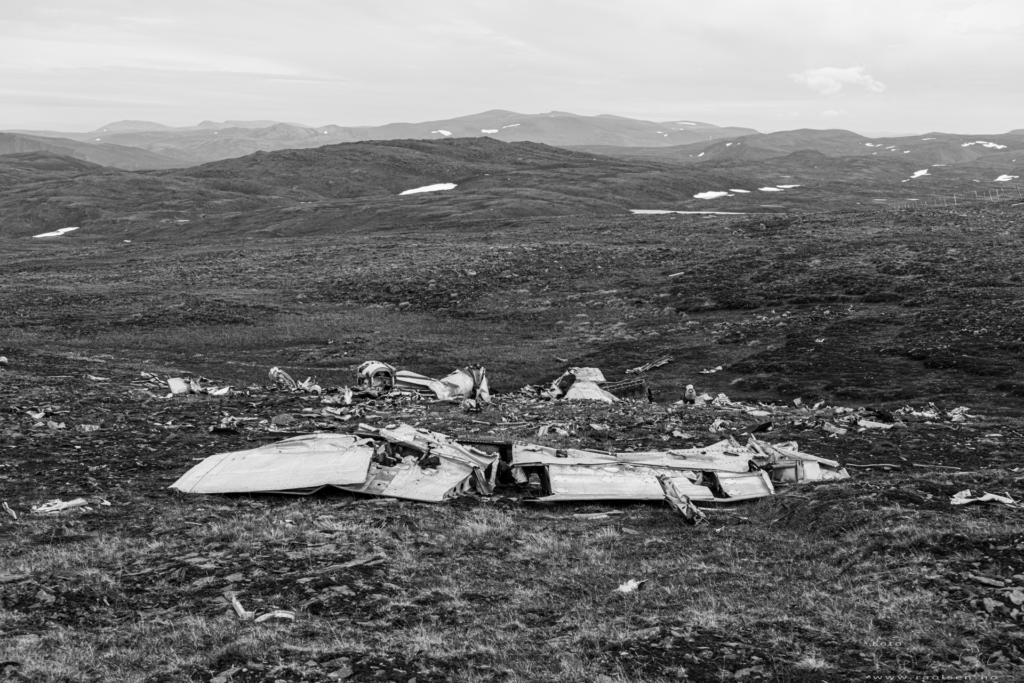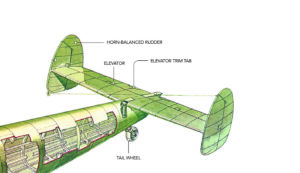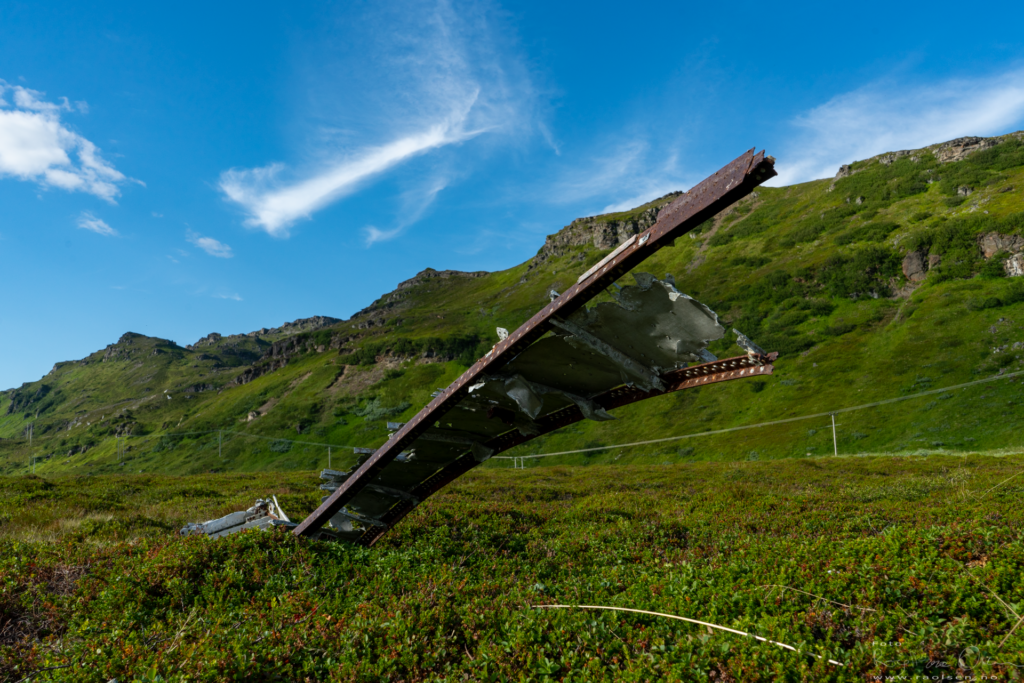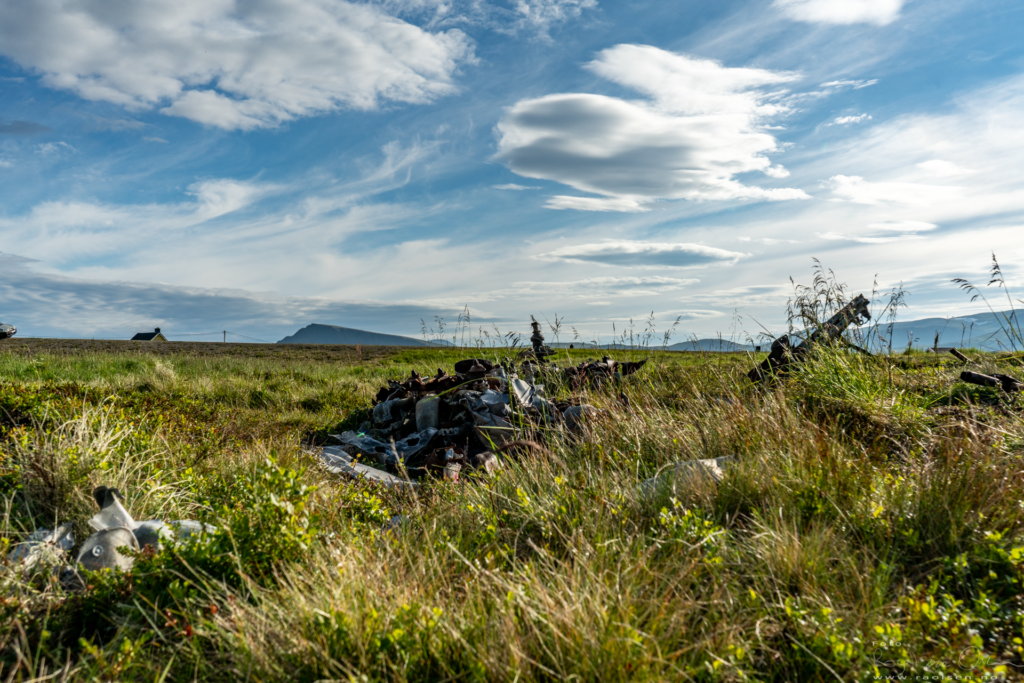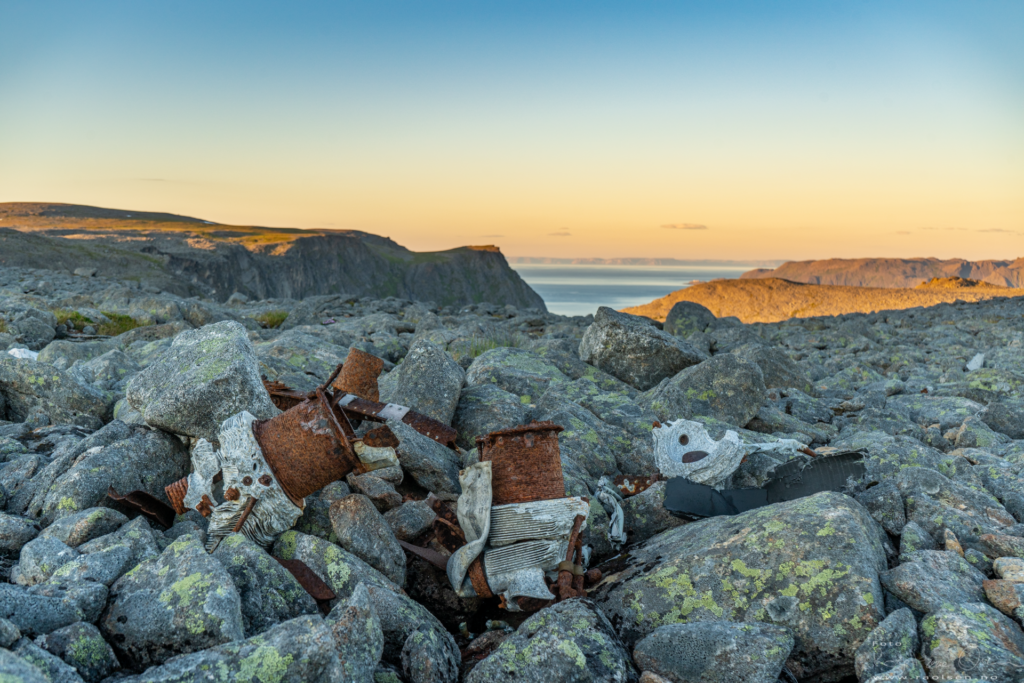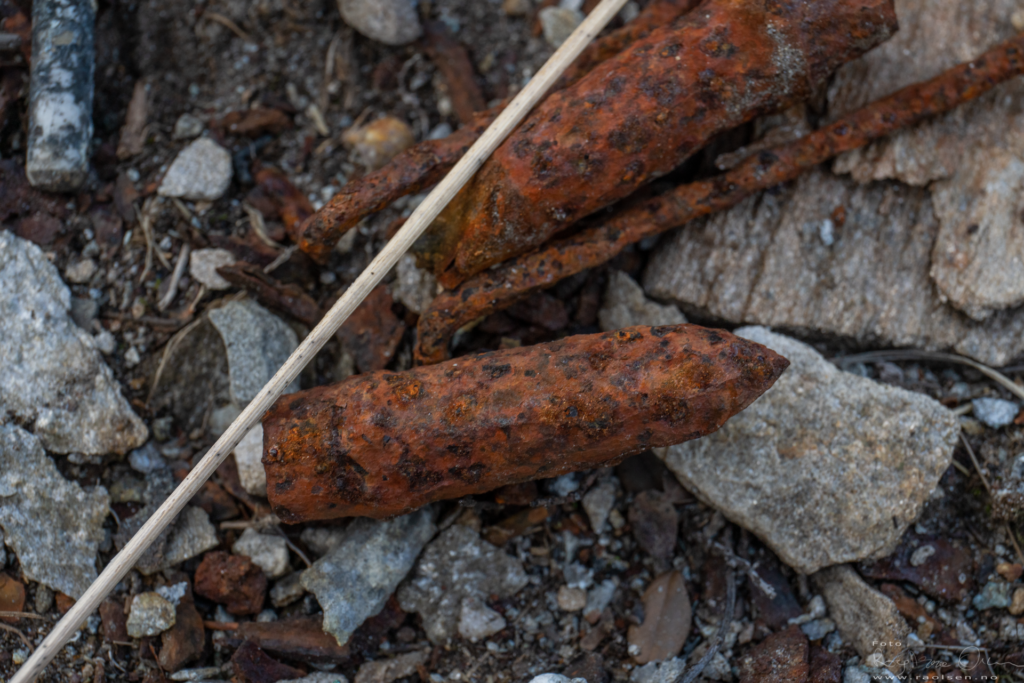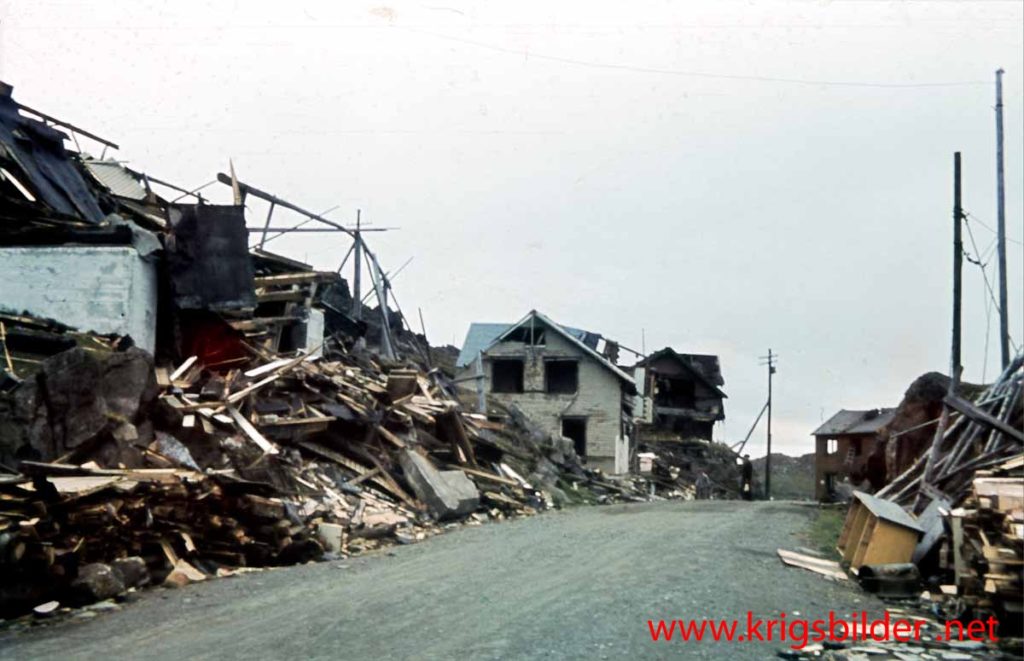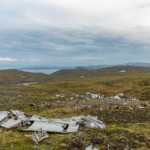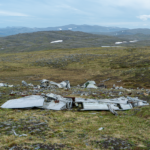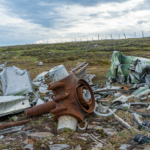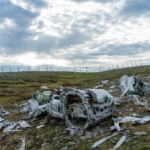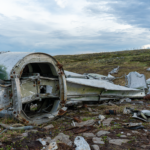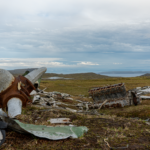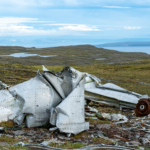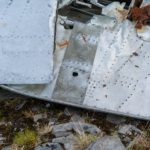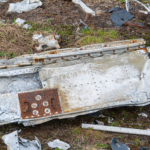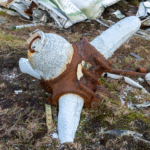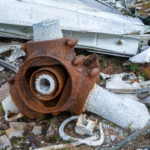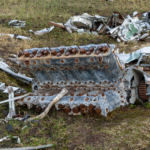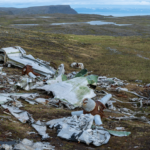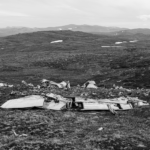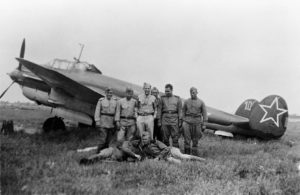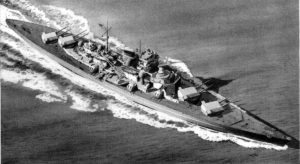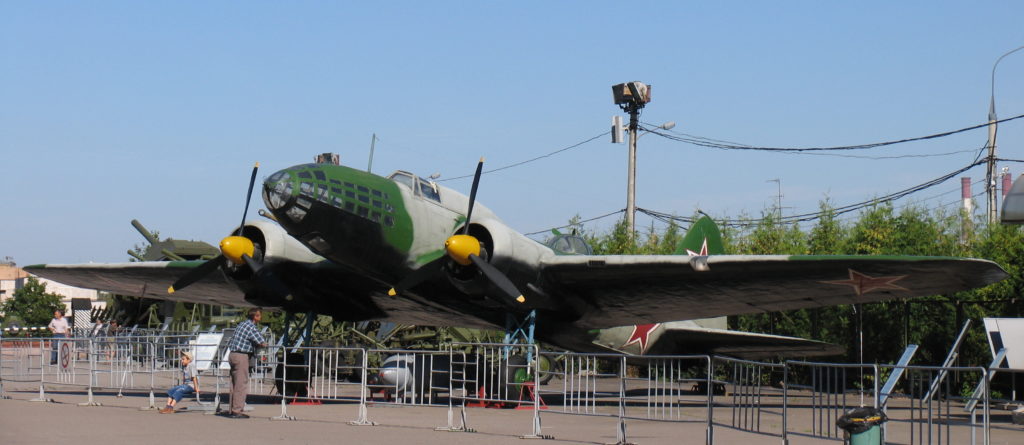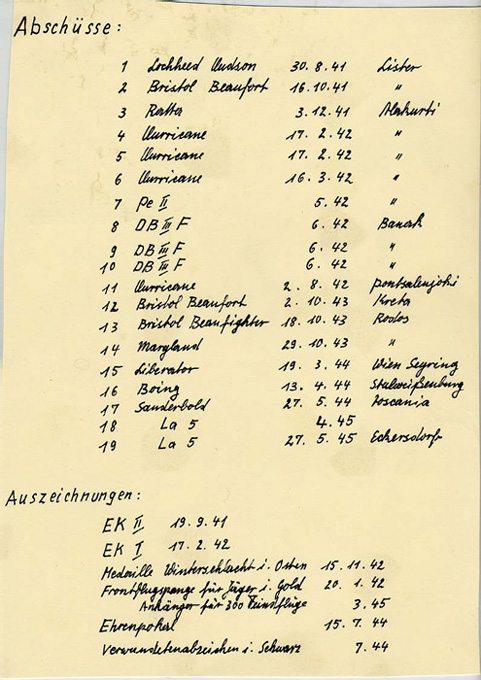When photography turns into history
 Sometimes when you are out shooting photos you might stumble over something that makes you like to know more about the motive you are shooting photos of. This summer (2020) I had one photo trip like that with a friend of mine. It all started with a plan to go fishing in one of our small lakes on the island of Magerøya.
Sometimes when you are out shooting photos you might stumble over something that makes you like to know more about the motive you are shooting photos of. This summer (2020) I had one photo trip like that with a friend of mine. It all started with a plan to go fishing in one of our small lakes on the island of Magerøya.
Our trip was just going to be a fishing trip with some fishing rods, our dogs and of course one of my cameras. It was so easy and calm when my friend asked me if I have seen the wreck of the World War II aircraft situated close to our path. Of course, we had to go there to have a look at that and then all changed, and it was the start of this article.
Entering a wreck site
After a short ride with a car from my home in Honningsvåg (about 15 km), it was time to do the walk to the wreck site with my friend as a pathfinder and two dogs that love to do the trip. At first, we find a few small pieces of something I think is the fuselage, just small pieces of thin aluminium. My first thought was that there will not be much left of a crash site and I got a little disappointed.
After a while, we see fewer parts and I think that was all and there will be nothing to see or shoot photos of. Then everything changes when the main wreck site reveals itself for us.
My first feeling when we arrived the site was excitement over the great view, then after a short time I got to feel the horror of the scene and I start to think about the crew of the aircraft. Did they survived or did they died at impact? Just being there rise so many questions that I like to know more about. What happened, what kind of aircraft was it?
My first research
Already when I was at the site I knew that I would need to know more about this aircraft and the history of it. Even if it was in the middle of the night when we got back from the fishing trip I could not help starting to do some research.
My first clue was the part I was sure had to be a part of the aircraft’s tail.
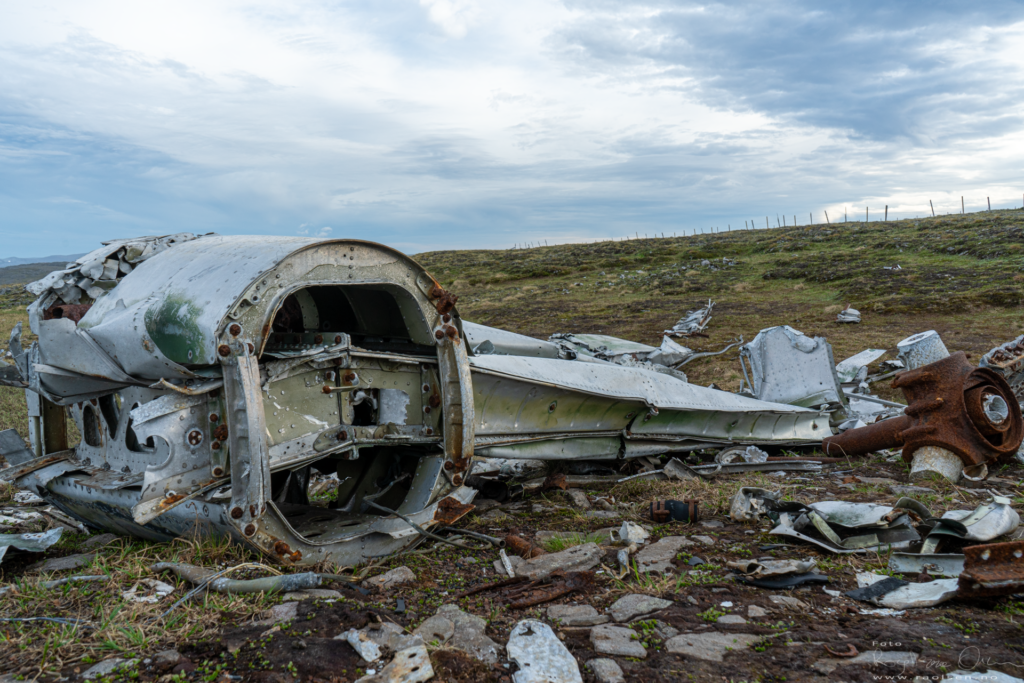
In my opinion, it had to be a tail looking something like this:
Together with the engine and propellers, I ended up with the Petlyakov Pe-2 or Pe-3 used by the Soviet Union during World War II. For the curious one, I used this page on Wikipedia when identifying the aircraft.
Some confirmation of my research
The day after our trip my friend and I got together and talked about the aircraft and I told him that I like to know more about it. Luckily, he had someone to ask for advice to get some more information. His contact told us to go to the website World War II Aircraft wreck sites in Norway
Right there we got the confirmation about the aircraft and some more information. The aircraft was a Petlyakov Pe-3 from Sovjet just as my research had told me. If I had done my research the right way I should have been able to find it much faster if I just had done a search on Google for “flyvrak på Magerøya” (aircraft wreck on Magerøya). But how fun would that be? 🙂
This is similar to how the aircraft would have looked like before the crash.
Photo by aeroprints.com, CC BY-SA 3.0, https://commons.wikimedia.org/w/index.php?curid=32552142
The story about the last flight for Petlyakov Pe-3
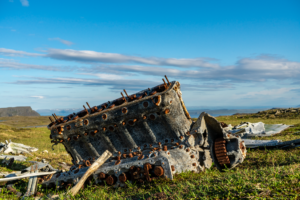 The aircraft was on an aerial reconnaissance for the battleship Tirpitz in Altafjord (Kåfjord). It was shot down in the vicinity of Sarnes at 15:56 on the 30th of Mars 1943 by Fw Heinz Käppler of 11./JG 5 in a Messerschmitt Bf 109 G.
The aircraft was on an aerial reconnaissance for the battleship Tirpitz in Altafjord (Kåfjord). It was shot down in the vicinity of Sarnes at 15:56 on the 30th of Mars 1943 by Fw Heinz Käppler of 11./JG 5 in a Messerschmitt Bf 109 G.
The crew of the Petlyakov Pe-3 was:
SSgt. Aleksandr I. Katyshev (KIA).
Lt. Jurij V. Terentev (KIA).
They both jumped out in a parachute. One is said to have been picked up by a Norwegian fishing vessel, but was already dead at this time. According to Russian archives, none of the crew returned to the Soviet Union after the war.
The German pilot Heinz Käppler was KIA 2/11/1944 according to the book “Arctic Bf 109 and Bf 110 Aces” of the author John Weal.
This aircraft is one of several aircraft that were shot down over Magerøya. It looks as if four planes from the Soviet Union were shot down over Magerøya. The other three were of the type Ilyushin DB-3F / Il-4 and they were all shot down on the same day (see separate sections) by the same German pilot.
In addition, a German JU88 aircraft crashed in Nordvågen and a German aircraft of the type Blohm & Voss BV 138 crashed on the mainland but still in the municipality (Mannskarvika).
If anyone have some updates about one of this aircraft or one of the others here at Magerøya I would then love to learn more and maybe update this post with some more information. I can be reach on this email address or contact me at my photo page at Facebook.
Ilyushin Il-4 at Sarnes
This is probably the aircraft wreckage most people know about and that most people have seen since it is located just off the road E69 at Sarnes.
Aircraft: Ilyushin IL-4, SNo 7520
The Soviet crew consisted of the following persons from; 35 MTAP VVS SF (Mine-Torpedo Aviation Regiment):
• Dolinov, Alexei Andreevich SLt (POW)
• Jagodkin, Vasilji Ferdorovich SLt (POW)
• Marenukha, N.N. Sgt (KIA)
• Zhukov, Nikolaj, Ivanovich JSgt (KIA)
Marenukha and Zhukov died on the spot when they did not get out of the plane before it went down. Dolinov was captured on Kistrand 18.08.1942 by the army and handed over to the Luftwaffe. He later died in German captivity. Jagodkin parachuted and ended up in the sea at Sarnes and was captured and interrogated for the first time on Banak (Lakselv) on 21.07.1942. He later returned to the Soviet Union.
Ref: TsVMA / Rune Rautio
Like the plane at Sarnes, this was also shot down by LT Kurt Hammel. Kurt Hammel was at the time stationed on Banak 4./JG5 and the plane was of the type Messerschmitt 109 E1. According to my work, this plane still exists and I am reasonably sure that this is the one you can watch in the UK (SEE LINK).
The aircraft on Duksfjordfjellet was one of four Ilyushin IL-4 aircraft that had the task of bombing a convoy of German ships in Honningsvåg harbour. This was probably a sequel to the bombing on 14 / 7-1942 where Honningsvåg was badly damaged when a barge with ammunition exploded. As stated in the Sarnes section, three planes were shot down the same day. I have so far not been able to track down the third aircraft and it may have ended up in the sea. If anyone has heard of fishermen who have been given some parts that may have originated from a plane in their nets, it would have been nice to hear about it.
Ilyushin Il-4 at the mountain Duksfjordfjellet
I still lack identification for this wreck, it is between the two aircraft with serial no. 6704 or 7611.
Of the three wrecks I have visited, this is probably the one that looks most brutal, here it looks like there has been some serious high speed at the impact moment and the parts are scattered in a completely different way than the other two crash site I have been at.
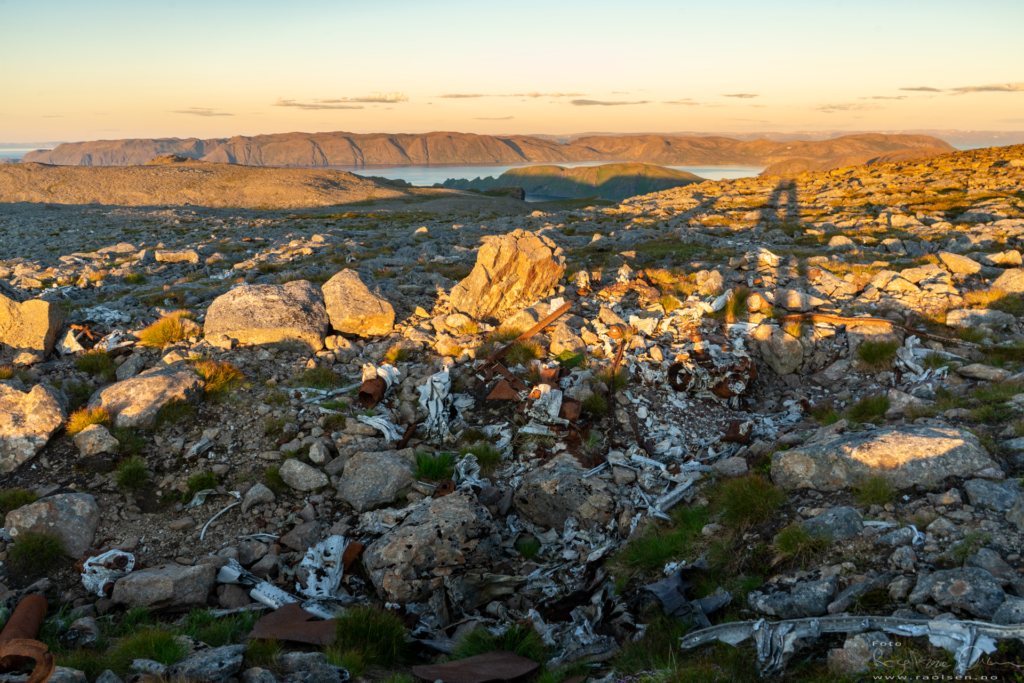 This (picture above) appears to be the impact area itself and is a pit in the ground that appears to be from the violent forces of the crash moment. In this pit lies most of one engine while the other appears to be scattered over a large area.
This (picture above) appears to be the impact area itself and is a pit in the ground that appears to be from the violent forces of the crash moment. In this pit lies most of one engine while the other appears to be scattered over a large area.
Aircraft: Ilyushin IL-4
The entire crew of four died on the spot and was buried near the wreckage on Duksfjordfjellet by residents from Skarsvåg (unverified source). Can not say who the crew was until I get identification of at least one crew member or something that can help identify the aircraft’s serial number. So far I can only say that the Soviet crew was from the department; 35 MTAP VVS SF (Mine-Torpedo Aviation Regiment). If anyone has parts or personal belongings from the crew that have been picked up on the spot, I would like to see these in the hope that I may be able to find the identity of the plane and those who died on the spot.
The plane was shot down by LT Kurt Hammel in his Messerschmitt Bf 109. Hammel was at the time stationed on Banak 4./JG5 (See fact box). The aircraft was one of four (?) Ilyshin IL-4 aircraft that were tasked with bombing a convoy of German ships in the harbour of Honningsvåg. Of these aircraft, Hammel is said to have shot down three where the location of two of these is known. The third I have not been able to track down and may have ended up in the sea. The other aircraft that is located is at Sarnes (see separate section). In addition, one aircraft is said to have been damaged but still managed to return to base.
Two German aircraft
In addition to the Soviet planes, two German planes have gone down here in the municipality, one in Nordvågen and one on the mainland (Mannskarvika).
The plane in Mannskarvika is a Blohm und Voss BV138 C-1 WNr.311036 is said to have crashed into the rock wall due to an accident on 8 / 12-1943. The entire crew of four died at the site.
3./I.(F)SAGr.130 (Seeaufklärungsgruppe 130) was stationed at the seaplane port in Billefjord at that time. The unit was stationed there between August 1943 and November 1944 and had just under 10 aircraft at most. In addition, there were several other departments stationed at the seaplane port in Billefjord.
Crew:
Oberleutnant Hermann Hahn
Fw.Wilhelm Botzenhart
Hauptmann Gerhard Grosse
Uffz.Hans Schellehaas
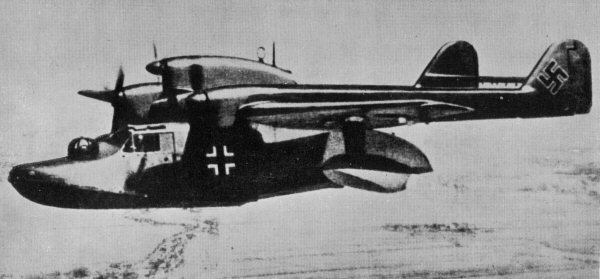
I have very little information about the aircraft in Nordvågen, but according to Rangvald Larsen, the wreck of the plane must have been dumped in the sea by German soldiers after the accident so there is no wreckage to visit. Not easy to tell if the plane was a JU88 or a ME 109 since I get different planes from two different sources.
If it is a Junker JU 88 then it may be this that I have found some information about.
Ju 88A-5 WNr 2424 belonging to 1./KG 30, This plane went down on 6 August 1941. Probably injured in air battle during an attack on Vaenga airport near Murmansk in the afternoon. Landed on land “By North Cape”. The entire crew was killed in the crash and was buried at Banak.
Crew:
Oblt Friedrich Meinhof (born 8/3/1913)
Fw Hermann Lutz
Uffz Karl Köhn
Uffz Arthur Groth
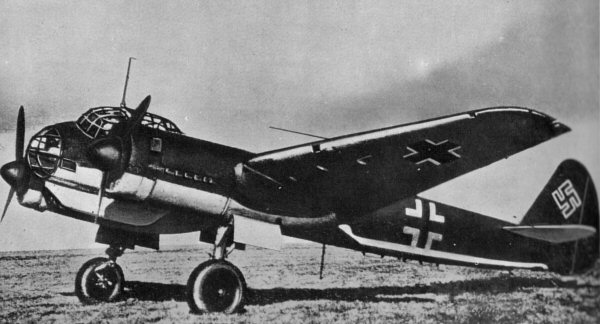
The bombing of Honningsvåg harbour
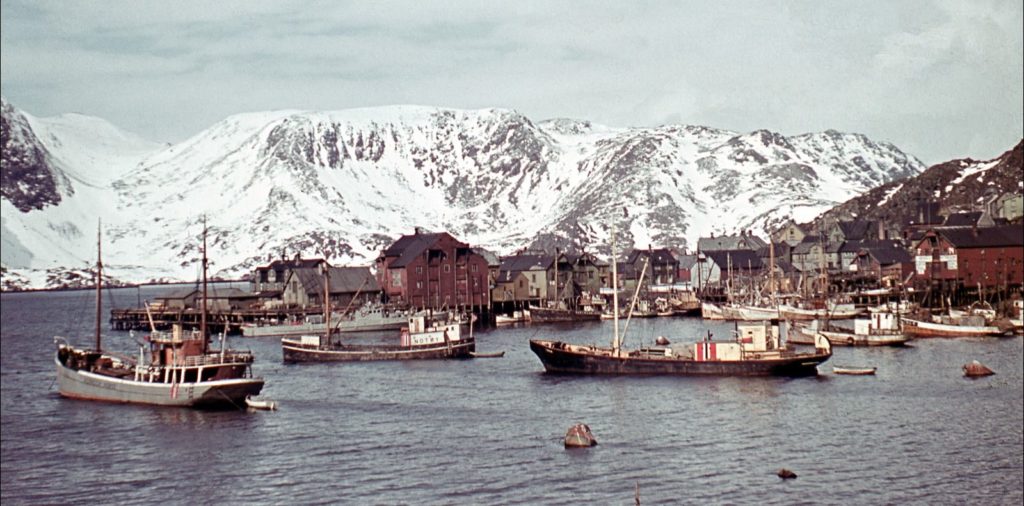
All of the Soviet Ilyushin Il-4 was on a mission to bomb a German convoy of 28 vessels that were in the harbour of Honningsvåg. They managed to sink two ships, MK Aud and MK Store Bill. Four Norwegian sailors are said to have died on MK Store Bill.
It is part of the story that 20 tons of potatoes were lost during the attack. Perhaps “lost” is wrong since it must have rained potatoes all over Honningsvåg and it is said that many of the civilians gathered potatoes. They should have tasted reasonably good if you cooked them a couple of times.
Five days before, the port of Honningsvåg was also bombed, which resulted in a barge / boat with ammunition and dynamite exploding. This is what it looked like in Honningsvåg after the powerful explosion ..
Credits and thanks
First I need to thank my friend Lars Eirik Isaksen for bringing me to the wreck site and for the support when research for the information used here.
I also need to tell how grateful I am for the website “Flyvrak” and for the nice job Kjell Sørensen do there.
Lofoten Krigsminnemuseum by William Hakvaag photos from the book “De Utrolig Bildene – William Hakvaag”.
Peter Neuwerth – www.jagdgeschwader5und7.de for photos regarding Kurt Hammel
Rangvald Larsen for information about the German aircraft’s
As always Wikipedia is a great source for information when you do stuff like this post. If you like my fact boxes on the right side of this post you should consider to do a donation to Wikipedia. You can do that on this link to their website.
The gallery of photos from the site
Magerøya
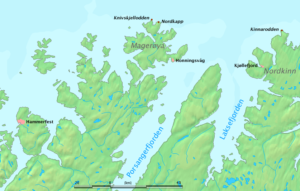 Public Domain,
Public Domain,
https://commons.wikimedia.org/w/index.php?curid=660397
Magerøya (Northern Sami: Máhkarávju) is a large island in Troms og Finnmark county, in the extreme northern part of Norway. The island lies along the Barents Sea in Nordkapp Municipality, just north of the Porsanger Peninsula. The mouth of Porsangerfjorden lies off the east coast of the island.
Magerøya has an area of 436.6 square kilometres (168.6 sq mi) and the highest elevation on the island is the 417-metre (1,368 ft) mountain Gråkallfjellet. The most northern point on the island is also the northernmost point in Norway outside Svalbard: Knivskjellodden. The island features a bleak, barren, tundra-covered landscape devoid of any trees (except for a few small pockets of mountain birch), with steep cliffs along the coast, and dramatic mountainscapes in the interior. On southern Magerøya, archaeologists have found evidence of settlements dating back 10,000 years.
Source: Wikipedia
Petlyakov Pe-3
The Petlyakov Pe-3 was the long-range heavy fighter version of the successful Petlyakov Pe-2 high-speed dive bomber used by the Soviet Union during World War II.
Its design and use followed a comparable path to those taken by the German Luftwaffe with the Junkers Ju 88 and the British Royal Air Force with the De Havilland Mosquito. The Soviets realized the need for a night fighter after the first night bombing of Moscow during Operation Barbarossa. The Petlyakov Pe-2 was selected for modification as the most suitable aircraft available.
Source: Wikipedia
The Klimov M-105 engine
 The M-105, designed in 1940, drew heavily on Klimov’s experience with the Hispano-Suiza 12Y (license-built as the M-100). In addition to a two-speed supercharger, the M-105 had several improvements like two intake valves per cylinder and a counterbalanced crankshaft. The M-105 was the first Klimov V-12 engine design to use reverse-flow cylinder heads, forcing the induction system to be placed on the outside of the cylinder banks, with the exhaust system also exiting from the outboard side, with twin sets of “siamesed” exhaust ports adjacent to each other. About 129,000 M-105 and its variants were built.
The M-105, designed in 1940, drew heavily on Klimov’s experience with the Hispano-Suiza 12Y (license-built as the M-100). In addition to a two-speed supercharger, the M-105 had several improvements like two intake valves per cylinder and a counterbalanced crankshaft. The M-105 was the first Klimov V-12 engine design to use reverse-flow cylinder heads, forcing the induction system to be placed on the outside of the cylinder banks, with the exhaust system also exiting from the outboard side, with twin sets of “siamesed” exhaust ports adjacent to each other. About 129,000 M-105 and its variants were built.
Source:Wikipedia
Tirpitz
Tirpitz was the second of two Bismarck-class battleships built for Nazi Germany’s Kriegsmarine (navy) prior to and during the Second World War.
The commander of the Kriegsmarine, proposed in November 1941 that Tirpitz be deployed to Norway. The ship would be able to attack convoys bound for the Soviet Union, and to tie down British naval assets and deter an Allied invasion of Norway.
The British were determined to neutralise Tirpitz and remove the threat she posed to the Allied arctic convoys. Ten vessels were assigned to the operation. Only eight of them reached Kåfjord (Altafjord) in Norway for the attack, which began early on 22 September.
Three of the vessels successfully breached Tirpitz‘s defences, two managed to lay their mines. The mines caused extensive damage to the ship; A fuel oil tank was ruptured, shell plating was torn, a large indentation was formed in the bottom of the ship, and bulkheads in the double bottom buckled. Repairs lasted until 2 April 1944 in Altafjord.
Operation Catechism, the final British attack on Tirpitz, took place on 12 November 1944. In the aftermath of the attack, 82 men trapped in the upturned hull were rescued by cutting through the exposed bottom. Figures for the death toll vary from approximately 950 to 1,204.
Source: Wikipedia
Ilyushin Il-4
In 1938, the Ilyushin design bureau redesigned the Ilyushin DB-3 to ease production and improve its performance, the revised version receiving the designation DB-3F. The aircraft’s internal structure, particularly the wings, was extensively changed, eliminating the need for hand finishing of the structure, and with duralumin replacing the large scale use of steel in the earlier version. The fuselage nose was lengthened to give more room for the navigator/bombardier while reducing drag.
The prototype DB-3F, powered by the same 949 hp (708 kW) Tumansky M-87B engines of the DB-3M, was piloted on its maiden flight by Vladimir Kokkinaki on 21 May 1939. It successfully passed through state acceptance tests and entered production in January 1940, with the 1,100 hp (820 kW) Tumansky M-88 quickly replacing the M-87.
The DB-3F was redesignated Il-4 in March 1942. Some series had wooden outer wings and front fuselages to conserve metals, and throughout the production, engines and fuel tanks were upgraded for improved performance while retaining the same range.
However the most notable change was the addition of larger defensive guns in the turret, using the 12.7 mm UBT machine gun in place of the earlier 7.62 mm weapons. In addition, it was found that the gunners were attacked first, so blocks of armor were placed around the gunner positions.
This extra weight was not offset by the newer engines however, and the Il-4 proved to be slower than the earlier versions at only 404 km/h (251 mph). An attempt to improve performance was made as the Il-6, adding large diesel engines and heavier armament. The engines proved unreliable and production was never started. The Il-4 remained in production until 1945, when just over 5,200 had been built.
General characteristics
Crew: four (pilot, bombardier/navigator, dorsal gunner/wireless-operator, ventral gunner)
Length: 14.76 m (48 ft 5 in)
Wingspan: 21.44 m (70 ft 4 in)
Wing area: 66.70 m2 (718.0 sq ft)
Empty weight: 5,800 kg (12,787 lb)
Max takeoff weight: 12,120 kg (26,720 lb)
Powerplant: 2 × Tumansky M-88B 14-cyl. air-cooled radial piston engines, 820 kW (1,100 hp) each
Performance
Maximum speed: 410 km/h (250 mph, 220 kn) at 6,500 m (21,325 ft)
Range: 3,800 km (2,400 mi, 2,100 nmi) (max internal fuel), 2,600 km (1,404 nmi; 1,616 mi) with 1,000 kg (2,200 lb) bombs
Service ceiling: 8,700 m (28,500 ft)
Time to altitude: 13.6 min to 5,000 m (16,404 ft)
Source: Wikipedia
Oblt. Kurt Hammel 4./JG 5
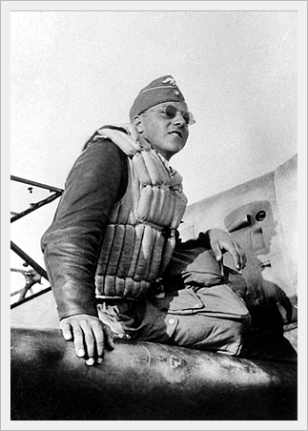
Kurt Hammel was stationed at Banak (Lakselv) at J.G. 5 4. Staffel from 21.06.1941 and until 30.07.1943. It means he left Banak eleven days after he shot down the three Ilyushin Il-4 at Magerøya. Hammel was flying the Messerschmitt Bf 109.
Kurt Hammel’s handwritten list over aircraft’s he has shot down. Listing at line 8, 9, and 10 is the aircraft that was shot down here at the island. Notice that he got the date wrong for some reason.
Photo source: Peter Neuwerth – www.jagdgeschwader5und7.de
Ltn Heinz Käppler 2/J.G. 5
Ltn. Heinz Käppler was the one that shot down the Petlyakov Pe-3 at Magerøya.
Ltn. Heinz Keppler St. Kap. of 15/JG 5 who was killed when his aircraft overturned on take off from Lister Airfield and burst into flames on 24th. March 1945. The aircraft was a Bf 109 G-14 w.n. 46415
An former Pilot who saw the accident live. He was telling it like this:
It was a typically take-off accident of a Me109. The plane pulling to the side (I dont know if left or right) an then overturn. Ltn. Käppler firstly was completely unwoundet. But he lays upside down, so the helper can’t free him quickly. And then, this was the tragedy, the cockpit was flooded from the tank with fuel. The helper needed more than two hours to get him free from the cockpit, and meanwhile he was drowned by his own fuel.

